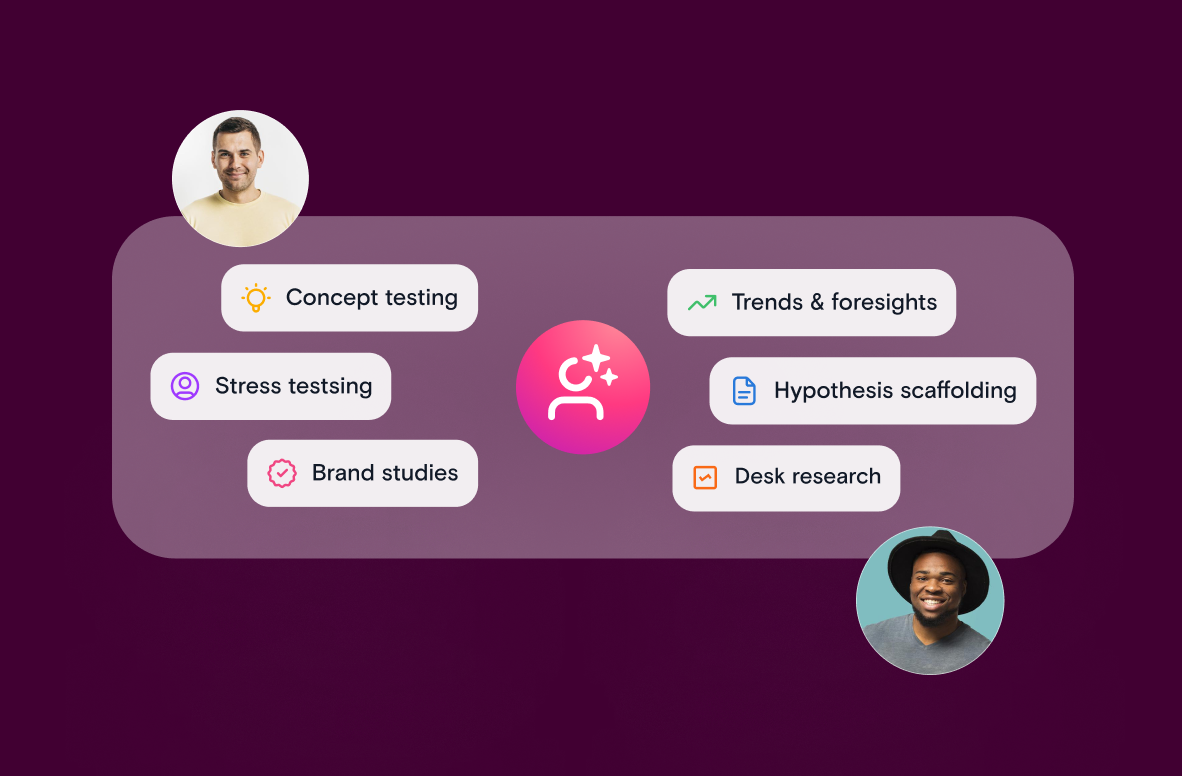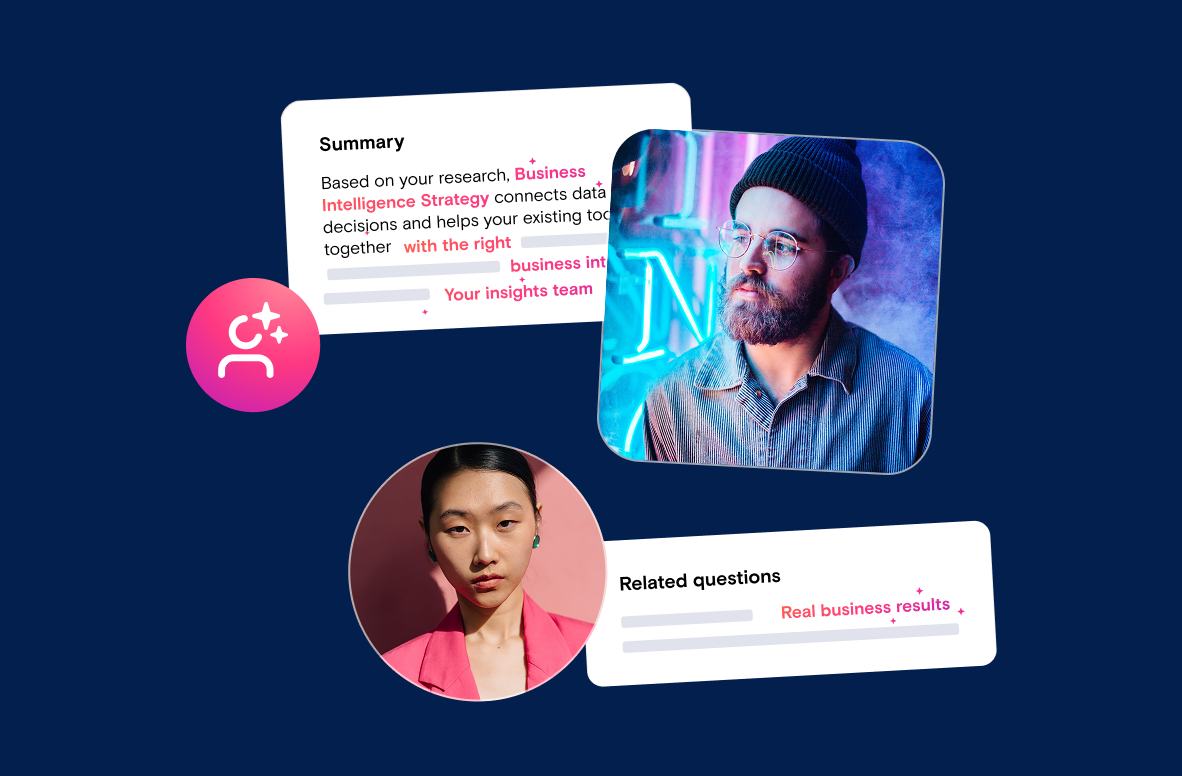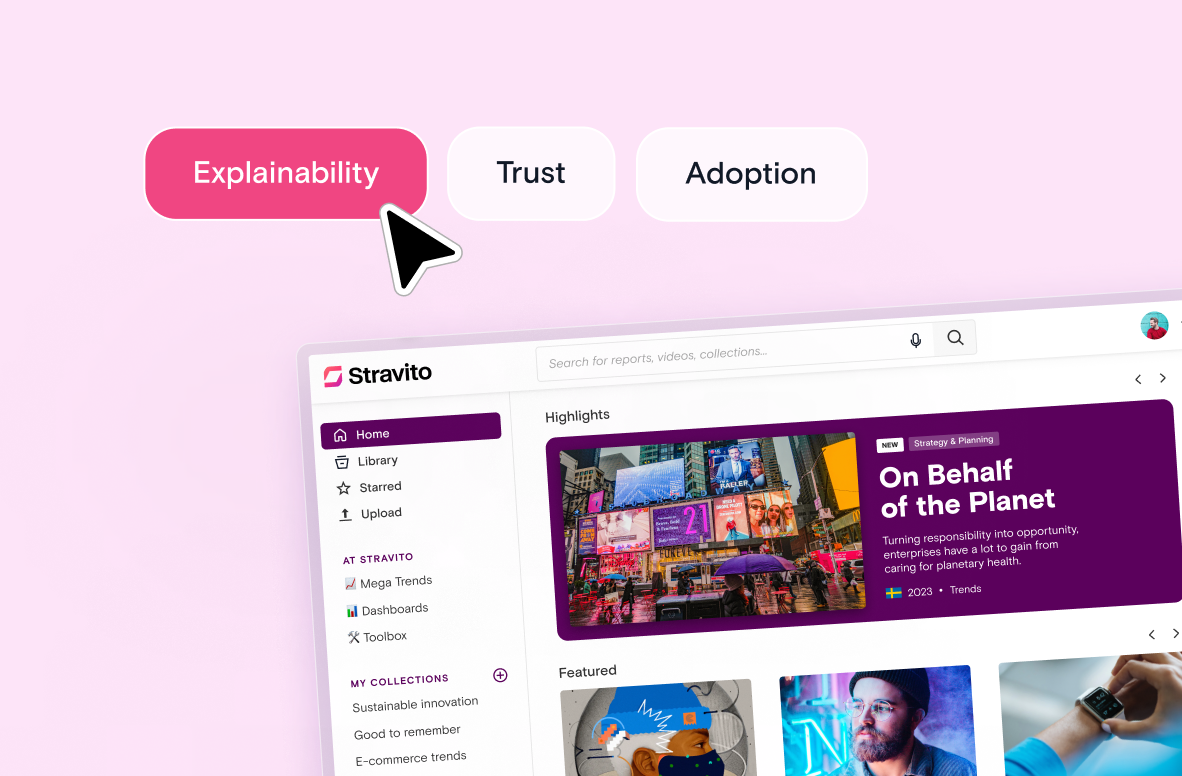TL;DR:
- Synthetic personas are AI-generated stand-ins that help you create diverse synthetic data, pressure-test ideas across various scenarios, and accelerate user research setup.
- Use them for persona-driven data synthesis, scaling synthetic data creation with personas across markets, and quick concept checks with synthetic users.
- They augment, not replace, real people. Always link outputs to human evidence and validate before decisions.
- Good governance matters: bias checks, inclusive language usage, clear provenance, and privacy rules.
- Centralize human and synthetic persona assets in one persona hub to keep sources attached, compare deltas, and share decision-ready insights.
You need answers fast, and your stakeholders still expect rigor. Synthetic personas help you move with both.
Think of synthetic personas as accelerators for enterprise insights. They let you explore ideas, surface blind spots, and draft hypotheses in hours by synthesizing world knowledge, web data, and your own research with a large language model.
You can address mass audiences by spinning variants for regions and channels, then narrow to the few that deserve real-world testing. This gives your teams a way to involve various perspectives quickly, generate insights across scenarios, and keep the process relevant.
Used well, synthetic personas save time, reduce obvious misfires, and widen scenario coverage, while your primary research keeps you honest.
Synthetic personas, defined (and what they are not)
Synthetic personas are AI-generated, probabilistic profiles that emulate the attitudes and behaviors of a target segment using modeled data.
They’re designed to help you create diverse synthetic data and explore various scenarios without waiting weeks for fieldwork.
What they are not
- Human research is still the benchmark — real participants, real contexts, real trade-offs. Synthetic personas can be assembled from the very same sources (interviews, surveys, transcripts, behavioral data) and can absolutely replace manually assembled persona documents. What they cannot replace is human-to-human research for discovery, validation, and decision-making.
- Synthetic personalization in media or communications is a tactic for addressing a mass audience as if they were individuals. That’s a messaging technique, not a research method, and it shouldn’t be confused with persona synthetics.
Why now
Advances in large language models have made persona-driven data synthesis possible at scale. For example, let’s look at persona hubs.
A persona hub is a centralized workspace where all persona assets live together — human-researched personas, synthetic personas, their supporting evidence (studies, transcripts, clips), versions and deltas, and governance metadata (owners, freshness, validation status). It’s not just a library; it’s the system of record for who your customers are, how they differ by market, and how those understandings change over time.
Research on Persona Hub shows how enterprises can use persona hub’s use cases to generate synthetic users, run testing across various perspectives, and surface pain points that deserve validation with real people.
For research teams, this represents a paradigm shift. You can synthesize knowledge-rich texts, involve users in direct address scenarios, and fully exploit the process by moving faster from idea to insight.
Instead of being limited by access to the world’s total population of participants, you can generate persona synthetics that capture almost every perspective, then validate with humans where it matters most.
Synthetic personas are gaining traction because they give your business the ability to test more concepts, with more audiences, in less time.
The payoff isn’t just speed. It’s the profound impact of widening your research lens while keeping evidence accurate and grounded.
When synthetic personas are useful, and when they are not
Synthetic personas can give your teams speed, flexibility, and scale. They’re especially helpful when you need to explore ideas, pressure-test messages, or create diverse synthetic data that reflects various perspectives.
But they’re not a silver bullet. Let’s look at where they can add value to your research, and where they can lead you off track.
Responsible use cases
Desk research acceleration
Your teams often lose time drafting proto-personas, digging through web data, and imagining day-in-the-life scenarios.
Synthetic personas help by producing quick profiles that surface pain points, highlight relevant insights, and outline various scenarios you might miss.
NielsenIQ shows how this reduces friction and gets you to sharper study designs.
This is where scaling synthetic data creation with personas becomes a practical tool.
By introducing a persona hub, you can create diverse synthetic data sets, store them alongside human evidence, and let users engage with them to stress-test your ideas.
Early creative and concept stress tests
Creative teams know the risk of cultural missteps. Before investing in a campaign, you can use persona synthetics to test language use, message framing, and direct address styles with synthetic users.
Forbes reports that this kind of testing reduces creative errors and maximizes upside.
Showcasing the persona hub’s ability here is powerful. Regional teams can compare how different audiences respond to speech, media, or device-specific concepts.
The process creates a feedback loop that helps you refine faster and fully exploit early creative tests.
Multimarket hypothesis scaffolding
If you’re working across multiple regions, synthetic personas help you spin regional variants to identify what must be validated in-market.
They let you explore context, regulatory nuances, and local pain points.
This doesn’t replace user research. It’s about potentially driving a profound impact by helping your business arrive at sharper hypotheses and more focused questions.
Synthesizing high-quality mathematical perspectives into knowledge-rich texts gives you confidence to engage with various audiences more effectively.
Synthetic data augmentation for model training
Sparse categories and small segments make model training difficult.
Synthetic data creation can supplement these gaps by generating labeled prompts, scenarios, and logical reasoning problems that widen your coverage.
Think of this as a practice ground. You can test capabilities, refine concepts, and involve distributed carriers of knowledge without confusing them with humans. It’s similar to how game NPCs help developers stress-test environments. They're useful for testing, but never a replacement for real players.
Misuses to avoid
Product-market fit or go/no-go decisions
It can be tempting to rely on persona synthetics for launch decisions. But NIQ warns that using them to forecast product-market fit risks overconfidence. These decisions still require human evidence.
Sensitive or vulnerable populations
Synthetic personalization won’t capture the lived realities of patients, children, or financially vulnerable groups.
Involving synthetic users in these contexts creates ethical and compliance risks that no process can fix.
Demand forecasting or willingness to pay
Synthetic data creation can’t tell you how consumers will behave in the market or what they’ll pay. The numbers may look accurate, but without human validation, they lack context.
Longitudinal learning
Synthetic personas are snapshots. They can’t track relationships, habits, or context shifts over time. Longitudinal research still needs real humans, real feedback, and continuous access to audiences.
Quick view: When to use vs. When not to use
|
Use them for |
Do not use them for |
|
Accelerating desk research |
Deciding product-market fit |
|
Creative stress tests |
Substituting sensitive or vulnerable groups |
|
Multimarket hypothesis scaffolding |
Forecasting demand or willingness to pay |
|
Synthetic data augmentation |
Longitudinal research on habits or triggers |
Stravito’s role
With Stravito AI Personas, you can manage human-researched and synthetic personas side by side — in one governed hub that keeps evidence, versions, and validation status attached. Here’s how Stravito helps:
- Single persona hub — Store human and synthetic personas together, link each facet to source studies, clips, and transcripts, and see version history and deltas as they evolve.
- Generate responsibly — Spin synthetic variants (by market, channel, or scenario) with prompts that inherit your context; outputs are auto-labeled with provenance, assumptions, and validation needed flags.
- Compare and validate — Run side-by-side comparisons of synthetic vs. human personas; capture confidence notes, bias checks, and owner sign-off before publishing.
- Localize at scale — Use a core-plus model to keep global jobs, triggers, and proof consistent — then layer regional language, regulatory notes, and channel nuances without rebuilding from scratch.
- Activate, not just archive — Attach personas to Collections, concept kits, GTM briefs, and enablement pages so marketing, product, and regional teams can reuse the same evidence-backed context.
- AI assistance — Stravito’s AI Assistant summarises studies, compares concepts, and surfaces contradictions — always with source links — to speed stakeholder digests.
- Governance built-in — Permissions, PII-safe guardrails, audit trails, retention rules, and policy tags ensure synthetic outputs are clearly marked as provisional until human research confirms them.
When teams can see synthetic outputs and validation side by side, they gain clarity on what’s exploratory vs. what’s decision-ready — letting you capture the speed benefits of synthetic personas without sacrificing trust.
How synthetic personas work
Synthetic personas aren’t magic. They follow a clear process that you can shape to your needs. The better you set up the inputs, the more accurate and useful the outputs will be.
Inputs
Everything starts with data. You give the system seed descriptors like segments, jobs to be done, and market facts. You also add context, such as tone, cultural markers, or constraints.
Some teams even use web data, past user research, or direct user prompts to make the profiles more relevant.
The goal is to create diverse synthetic data that covers various scenarios and perspectives without drifting into fantasy.
Generation
From there, a large language model gets to work. It synthesizes persona facets, scenarios, and responses, drawing on world knowledge and knowledge-rich texts.
Think of this as persona-driven data synthesis. The system pulls from distributed carriers of information and wraps them into one perspective encapsulated in a synthetic person.
This is where you see the shift. You’re no longer limited by the world’s total population of actual respondents you can reach in a week.
You can generate synthetic users at scale, explore almost every perspective, and pressure-test ideas faster.
Scaling
The power grows when you introduce a persona hub into your workflow. In practice, this hub can scale synthetic data creation across regions, channels, and languages. It also gives teams a shared space to compare multiple personas at once, see how users engage with direct address, and test language use across a mass audience.
Handled this way, scaling synthetic data creation with personas becomes a controlled process. It’s like adding a testing ground where consumers, communities, and audiences can be represented in scenarios before you commit to live validation.
Output handling
The final step is to manage the outputs responsibly. Each generated persona comes with assumptions.
You need to capture the feedback, attach confidence notes, and keep validation flags visible.
The process should show where the ideas came from, how the insights were created, and where human research must step in.
Handled this way, synthetic personas aren’t a shortcut. They’re a tool to expand your view, sharpen your testing, and involve more perspectives in less time.
A responsible workflow for enterprises
Synthetic personas are most useful when you work with them inside a clear process.
Think of them as a tool to create diverse synthetic data, not as a replacement for live users.
A structured workflow keeps the insights relevant, accurate, and trusted across your organization.
1) Frame the question and name decisions
- What decision will this work inform in the next 2–4 weeks?
- Which scenarios must still be validated with humans?
Framing early helps you avoid wasting effort on synthetic users that can’t influence the outcome.
2) Constrain generation with real evidence
Start with the knowledge you already have:
- Past user research and consumer interviews
- Market facts and world knowledge
- Inclusive language usage examples
Feed this into your persona hub so each synthetic output stays connected to human data.
For help structuring evidence, see Stravito’s knowledge management framework and how to create a knowledge base.
3) Generate, then antagonize
Don’t rely on a single persona. Instead:
- Spin multiple persona synthetics
- Set them to debate across various perspectives
- Prompt them to highlight missing pain points or contradictions
This isn’t about synthesizing high-quality mathematical formulas. It’s about stress-testing concepts with knowledge-rich texts that represent different audiences.
4) Mark outputs as provisional
Every persona hub entry should clearly show:
- The user prompts used in creation
- Assumptions and confidence notes
- A “validation needed” flag
This makes sure users engage with outputs as previews, not final truths.
5) Validate fast with humans
- Run micro-studies or diary probes with consumers
- Compare synthetic insights against live feedback
- Capture the deltas between synthetic and human responses
The difference often reveals the most relevant insights.
6) Store, socialize, and retire
- Save synthetic and human personas side by side in your persona hub
- Use Stravito’s AI knowledge management tools to share digestible briefs and feedback loops
- Retire or refresh persona synthetics quarterly
This process helps your community scale testing, involve almost every perspective, and keep outputs accurate.
When your teams follow these steps, scaling synthetic data creation with personas becomes safe and repeatable.
You can fully exploit the speed of generation while keeping consumers, audiences, and stakeholders confident in the process.
Now, we'll need to look at governance and risk controls because speed only matters if you can trust the outcomes.
Governance, ethics, and risk controls
Synthetic users can open new possibilities for research, but without strong governance, they risk leading your teams astray.
The challenge is about trust. If your stakeholders don’t trust the process, they won’t act on the insights. That’s why governance and ethics aren’t optional extras.
They’re the foundation that makes synthetic data creation safe to use at scale.
Provenance and audit
Every synthetic output is only as strong as the trail behind it. If you can’t show where it came from, your teams can’t rely on it.
- Capture the seed data, user prompts, and model versions you used.
- Store assumptions alongside each output in your persona hub.
- Keep change logs so the process is transparent from creation to retirement.
When you do this, your colleagues see the process, not just the persona. That transparency builds confidence in the insights.
Bias checks
Synthetic personalisation can look polished but still reinforce stereotypes. The risk is that teams act on insights that sound accurate but exclude important voices.
- Run bias prompts to check fairness across perspectives.
- Compare synthetic outputs against live user research to spot gaps.
- Apply inclusive language usage guidelines before you socialize findings.
These checks don’t take long, but they prevent small mistakes from snowballing into strategic blind spots.
Privacy and compliance
It’s easy to assume synthetic data creation means “no risk,” but that’s not the case. If you feed real identifiers into prompts, you’re not generating synthetic users — you’re exposing real ones.
- Never include PII in your generation process.
- Treat synthetic outputs as generated examples, not anonymized people.
- Align every step with your compliance team so the process holds up under review.
This protects both your organization and the communities you study.
Policy and accountability
Even with audit trails and bias checks, synthetic users need rules of engagement. Without them, they can end up in the wrong hands or used for the wrong purpose.
- Label every synthetic persona clearly.
- Forbid use in go/no-go calls or demand forecasting without human validation.
- Define how long synthetic personas stay active, and when they should be retired.
Finally, assign ownership. Someone in your organization should be accountable for a persona hub’s use cases, the accuracy of the outputs, and the process of refreshing them. Without an owner, even the best guidelines drift.
Governance is what turns synthetic personalization from a risk into a capability. With the right controls, you can fully exploit the speed of persona synthetics without undermining trust.
Now that you’ve seen how to manage the risks, let’s explore the toolchain pattern that makes this possible in 2026.
Toolchain pattern that works in 2026
By 2026, most enterprises will have learned that synthetic data creation isn’t about one shiny tool.
It’s about building a connected toolchain where each layer does its job and feeds into the next.
When done well, this setup gives your teams access to insights at scale, without losing the guardrails that make research trustworthy.
Here’s what good looks like.
Source of truth
Start with your research repository - the single place where human evidence lives.
It’s the anchor for all persona synthetics and the check that prevents you from drifting too far from reality. Without this foundation, synthetic users can’t be validated.
Generation layer
On top of that, you need a large language model workspace with guardrails. Think of it as the creative studio where persona-driven data synthesis happens.
- Use prompt libraries to speed up creation.
- Keep context attached so outputs remain relevant to your business.
- Ensure direct address and language use align with your audience standards.
This is where you move fast, but with structure.
Validation stack
Synthetic users can stress-test ideas, but humans confirm them. That’s why your toolchain needs quick-turn validation:
- Rapid qual interviews
- Concept testing across various perspectives
- Creative pre-flight to catch risks before they scale
This layer helps you balance speed with accuracy.
Knowledge layer
This is where Stravito plays a central role. By introducing a persona hub into your knowledge ecosystem, you can:
- Store synthetic and human personas side by side
- Organize them into Collections by market, scenario, or initiative
- Use AI knowledge management to generate knowledge-rich texts with clear sourcing
- Apply permissioning, audit trails, and retention rules
Stravito acts as the distribution hub for your insights, helping your teams engage with relevant data instead of getting lost in tools or files.
Sharing and activation
The final step is to make the process easy for your stakeholders.
- Summarize outputs into digestible briefs
- Share stakeholder digests or “insight-to-action” playbooks
- Track feedback so your persona synthetics improve over time
Handled this way, your toolchain isn’t just about scale. It’s about building a process that keeps humans and synthetic users working together, giving your business the confidence to act quickly on new ideas.
Where Stravito fits
Research only creates impact when teams can find it, trust it, and use it. Stravito Personas turns that principle into practice by unifying human-researched and synthetic personas in one governed hub — so exploration is fast, and decisions stay evidence-based.
With Stravito, you can:
- Centralize personas and proof
Keep human and synthetic personas side by side, with source studies, clips, and transcripts attached to each facet. Every change carries provenance, version history, and confidence notes.
- Generate responsibly — then validate
Create synthetic persona variants (by market, channel, or scenario) using prompts that inherit your context. Outputs are auto-labeled as provisional and include assumptions + validation needed flags until confirmed by human research.
- Compare, localize, and reuse
Run side-by-side comparisons (synthetic vs. human), apply a core-plus localization model for regions, and attach personas to Collections, concept kits, GTM briefs, and enablement pages for easy reuse.
- AI that accelerates synthesis — not spin
Stravito’s AI Assistant summarises studies, compares concepts, and surfaces contradictions — always with source links — so stakeholder updates are faster and grounded.
- Governance you can trust
Enforce permissions, retention rules, audit trails, and PII-safe guardrails. Bias-check prompts and policy tags ensure synthetic outputs are clearly marked until validated.
Want to see how this could work for your business? Request a Stravito demo.
FAQs
What is a synthetic persona vs a human persona?
A synthetic persona is generated by AI using modeled data. A human persona is built from real user research and representative samples.
Are synthetic users replacing research participants?
No. Synthetic users speed up early exploration, but they do not replace real participants in research.
How do we avoid bias and hallucination?
Use clear prompts, compare outputs to real data, and run bias checks. Always validate with human research before acting.
Can synthetic personas improve creative safety?
Yes. They can highlight cultural risks, test language use, and flag obvious missteps before you invest in full creative testing.
Where should we store and label them?
Keep them in a central hub alongside human evidence. Label clearly as synthetic, with sources and validation status attached.




